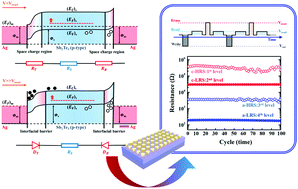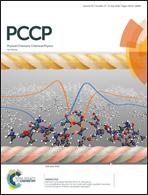Characterization of interfacial barrier charging as a resistive switching mechanism in Ag/Sb2Te3/Ag heterojunctions†
Abstract
In this study, bipolar memristive behaviors were systematically characterized in Ag/Sb2Te3/Ag hetero-junctions. By using in situ Raman and photoluminescence spectroscopy, a direct observation of the bonding environment and band structure confirmed that resistive switches are strongly related to the electronic valence changes in Sb2Te3 and the formation of Schottky barriers at Ag/Sb2Te3 interfaces. Band movement of Sb2Te3 acquired by first-principles calculations also supports the electrostatic barrier charging as a memristive mechanism of Ag/Sb2Te3/Ag heterocells. Independent resistance-switching behaviors that can be utilized in both amorphous and crystalline Sb2Te3 lead to multiple resistance values with a large memory window (104–105) and low read voltage (∼0.2 V), giving rise to a unique multi-level memory concept. This study based on Ag/Sb2Te3/Ag hetero-junctions offers a significant understanding to promote the use of Sb2Te3 and other chalcogenide memristors as promising candidates for compatible high-density memory applications.



 Please wait while we load your content...
Please wait while we load your content...